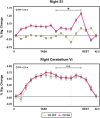Functional activity of the sensorimotor cortex and cerebellum relates to cervical dystonia symptoms
- PMID: 28594097
- PMCID: PMC5547035
- DOI: 10.1002/hbm.23684
Functional activity of the sensorimotor cortex and cerebellum relates to cervical dystonia symptoms
Abstract
Cervical dystonia (CD) is the most common type of focal dystonia, causing abnormal movements of the neck and head. In this study, we used noninvasive imaging to investigate the motor system of patients with CD and uncover the neural correlates of dystonic symptoms. Furthermore, we examined whether a commonly prescribed anticholinergic medication in CD has an effect on the dystonia-related brain abnormalities. Participants included 16 patients with CD and 16 healthy age-matched controls. We collected functional MRI scans during a force task previously shown to extensively engage the motor system, and diffusion and T1-weighted MRI scans from which we calculated free-water and brain tissue densities. The dystonia group was also scanned ca. 2 h after a 2-mg dose of trihexyphenidyl. Severity of dystonia was assessed pre- and post-drug using the Burke-Fahn-Marsden Dystonia Rating Scale. Motor-related activity in CD was altered relative to controls in the primary somatosensory cortex, cerebellum, dorsal premotor and posterior parietal cortices, and occipital cortex. Most importantly, a regression model showed that increased severity of symptoms was associated with decreased functional activity of the somatosensory cortex and increased activity of the cerebellum. Structural imaging measures did not differ between CD and controls. The single dose of trihexyphenidyl altered the fMRI signal in the somatosensory cortex but not in the cerebellum. Symptom severity was not significantly reduced post-treatment. Findings show widespread changes in functional brain activity in CD and most importantly that dystonic symptoms relate to disrupted activity in the somatosensory cortex and cerebellum. Hum Brain Mapp 38:4563-4573, 2017. © 2017 Wiley Periodicals, Inc.
Keywords: MRI; cerebellum; cervical dystonia; sensorimotor cortex; trihexyphenidyl.
© 2017 Wiley Periodicals, Inc.
Figures



References
-
- Balash Y, Giladi N (2004): Efficacy of pharmacological treatment of dystonia: Evidence‐based review including meta‐analysis of the effect of botulinum toxin and other cure options. Eur J Neurol 11:361–370. - PubMed
-
- Beck AT, Ward CH, Mendelson M, Mock J, Erbaugh J (1961): An inventory for measuring depression. Arch Gen Psychiatry 4:561–571. - PubMed
-
- Benjamini Y, Hochberg Y (1995): Controlling the false discovery rate: A practical and powerful approach to multiple testing. J R Stat Soc Ser B Methodol 57:289–300.
Publication types
MeSH terms
Substances
Grants and funding
LinkOut - more resources
Full Text Sources
Other Literature Sources

